Been crazy about tires from the beginning!
Still am.
Why?
No idea.
Fix Flats, Clint, Texas, 2024, photograph by James Yontrofsky
Been crazy about tires from the beginning!
Still am.
Why?
No idea.
Fix Flats, Clint, Texas, 2024, photograph by James Yontrofsky
’48 Chrysler, El Paso, Texas, 2022, photograph by Bruce Berman
Photograph and rumination by Bruce Berman
I’m out of words.
Taught photography for 25 years. F-stops, shutter speeds, composition, GET CLOSER!, on and on and on.
In the beginning there was just photography and me.
Burned out? Talked out?
In the end, what is there to say?
The world is LIGHT. Photography is Light-writing (Greek). Actually light-noticing, good and bad. And commitment to doing it. Pretending it can be taught is a wink. If you really have no heart for it and realize the part about sweating to get it (which is universal to all pursuits), why botha.
And then there is love.
The love you feel when it’s good. The love you get from others who felt what and how you saw something. The love you can give by giving your heart in the form of that image, whether it’s a print (especially if it’s a print), on a monitor or I don’t know what else.
There I go again.
Words.
Just can’t!
Do you love this image?
Text and photograph by Bruce Berman
Good ole days… when every inch wasn’t being developed.
It’s now a time of emptiness and greed and of “not enough of too much.” It’s too much.
There was a time of “Not enough was more than enough.” It looked better. Period.
Jean’s Gams, El Paso, Texas, 1975
Photo and Text by Bruce Berman
All the signs are gone, or gone to a hipster bar somewhere in America. The Funk is sanitized. Hosiery bar? Really? How un Gucci.
For me that era was a treasure chest waiting for me to open it and when I did… TREASURE!
You got anything to compare to this, now?
Somehow the Walmart Women’s section just doesn’t have the juice.
Is there anywhere on this planet now that isn’t manufactured?
I think there is.
Not sharing. Going. My soul needs authenticity. I guess everyone’s does. We’re on our own.
Rent ur _________?, El Paso, Texas, March 5, 2023 by Bruce Berman
For staff photographers working in the newspaper world, this kind of photo used to be called an “Enterprise Photo,” meaning the photographer, driving around, usually from assignment to assignment would be on the alert for feature photos that his/her editor might use to spice up the next paper’s edition … maybe.
Old habits die hard.
So, here’s today’s enterprise photo.
Right there, right in La Mesa, New Mexico, four days ago, is the lesson on why we do DOCUMENTARY PHOTOGRAPHY!
My documentary photography class at New Mexico State University (NMSU) has been doing a project for the past twelve years, the Small Village New Mexico project (SVNM), documenting the small villages in southern New Mexico.
One of the students’ favorites towns is La Mesa. Probably because there has been one guy, Joe Mees, who rebuilds cars and Harleys, and has always been very welcoming to the students. It doesn’t hurt that he looks very cool!
Last Thursday, we met Tim Mees, Joe’s son.. He told us of that “Joe has been bed-ridden for about a year.”
Punchout Kids, North side, Chicago, 1970, ©Bruce Berman
Text and Photo by Bruce Berman
Never too young, I guess.
We had ONE pair of gloves when I was a kid. I got the left-handed one and my day had the other.
He had a robust punch.
Ironically, his name was Punch.
LOL!
Photo and text by Ivan Perea
On November 3 at Mesilla Plaza in front of San Albino’s Basilica, the Journalism 320 (Photojournalism) class from New Mexico State University (NMSU) ran into a movie production scene being produced by the Creative Media Institute (CMI) department, which is a film-making department at NMSU. It was the last day of shooting on an independent film that began weeks before. The initial filming started in in Los Angeles.
Actor in a 1954 Chevrolet pickup, Mesilla, New Mexico, Nov., 2022
Photograph by ©Ivan Perea
Text by Bruce Berman
Photograph by Stephen Wilkes
My father, Irving “Punch” Berman was born on Ellis Island in 1906. It was the day his parents -my grandparents- arrived in America. He was the first American in our family.
He was grateful to be here.
The documentation of “The Island” by Stephen Wilkes is documentary photography at its best: it preserves our memories and it stimulates inquiry.
See Stephen’s work: https://stephenwilkes.com/fine-art/ellis-island/
Was this the exact room he was born in? Who knows?
Was this the exact clinic? Yes.
Was he an accidental American? Most definitely.
The mystery in our family was, always, twofold: a) why did they let them in? My grandfather, Jacob, was dead within 6 months, of Tuberculosis. He never made it out of the lower east side. He was that sick it must have shown as the entry guards were interviewing. His mother, my grandmother Anna, died of the same illness seven years later (in Denver). The immigration authorities usually sent the sick ones back on the boat as it turned around and went back to England or Lisbon or wherever. It normally would have been a long sail back to Odessa (which they were escaping from, from the Cossacks), or wherever they could afford to be. And, c) When did he become a Berman. For that matter when did he become Irving? I know how he became Punch because he told me so. That will have to wait for another post (tease tease).
My niece Isabel, has tracked down the family history and it turns out his name was Isidor Yonofsky.
Some secrets, I guess, are lost to the fogs of time.
Note: Much thanks Stephen Wilkes.
John Vachon, Chicago, 1940
Washington, D.C., circa 1920. “People’s Drug Store, 7th and M.” Your headquarters
for Bed Bug Killer, Corn Paint (“for Hard and Soft”) and the ever-popular Rubber Goods.
National Photo Company via Shorpy
Workers on the company boat, Golden Gate Bridge construction, 1935 by Peter Stackpole
(photo from an original print. Much of Mr. Stackpole’s work was lost in a 1991 fire)
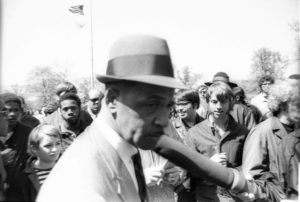
Old Civil Rights leader lost in the crowd, (from ChiTown Journal) Chicago, by Bruce Berman. 1968
TEXT AND PHOTOGRAPH BY BRUCE BERMAN
Eras are always changing. They’re changing now. Old liberals aren’t enough now, socialists may not be enough next year.
In 1968 the era was changing as well. In the photograph above, Martin Luther King had been assassinated only six months before. Bobbie Kennedy, only three months before.
The old Civil Rights movement was being paralleled by the anti-war movement. The old Baptist church arguments, high on morality and sincere ecumenicalism of previous years was being replaced by the Hell No I Won’t Go movement, sincere, but clearly lacking in thought-out ideology. “I won’t go,” isn’t a spiritually-driven theology.
In one of the many protests in the hot summer of 1968, in Chicago, during the Summer of Rage, Part II, the contrasts between these two eras was becoming evident and the clash was real. The old Civil Rights leaders’ voices were being drowned out by the new Black Nationalist voices of the Black Panthers and others. The middle class kids were more enraged by getting grabbed by the Draft Boards than they were by Segregationist southern sheriffs.
This photograph, shot in Lincoln Park, Chicago, in August 1968 was a glimpse into the divide to come. By September, 1969, fourteen months later, the divide was complete. MLK was gone. The Kennedys were gone, Black Panther Fred Hampton had been assassinated by the Red Squad of the Chicago PD, Bill Ayers and the SDS Weathermen started to learn the craft of bomb-building (and went underground one year later), and the old, moral voice of the Civil Rights movement was all but drowned out in the dark and strident days that tagged the next ten years in the coming 1970s.
Eras change.
High School Beach, Venice, California, 1949 by Max Yavno
Max Yavno worked as a Wall Street messenger while attending City College of New York at night. He attended the graduate school of political economics at Columbia University and worked in the Stock Exchange before becoming a social worker in 1935. He did photography for the Works Progress Administration from 1936 to 1942. He was president of the Photo League in 1938 and 1939. Yavno was in the U.S. Army Air Corps from 1942 to 1945, after which he moved to San Francisco and began specializing in urban-landscape photography.
He was one of several post war photographers who lived and worked in what became a new culture, the Southern California middle class leisure car culture.
Roy DeCarava was one of the most influential documentary photographers of the 1950s-1960s. He was known more for the simplicity and ordinariness of his work than for it being spectacular or showy. His particular importance was photographing the Black community of his native Harlem and for the jazz scene of the era.
For a more thorough descrtiption of DeCarava’s work check out the always insightful Claire O’Neil’s essay at: https://www.npr.org/sections/pictureshow/2009/10/decarava.html
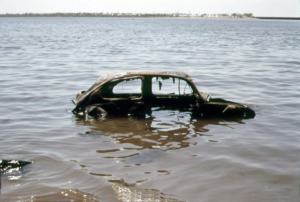 Abandoned Car in Jamaica Bay 06/1973 by Arthur Tress/Documerica Project
Abandoned Car in Jamaica Bay 06/1973 by Arthur Tress/Documerica Project
For more information on Arthur Tress click here.
Carole Warrington and her Menominees. Chicago, 1970 by Bruce Berman
On May 5, 1970, a group of American Indians set up an encampment behind Wrigley Field. Led by Indian activist Mike Chosa, and Menominee Carol Warrington, the Chicago Indian Village (CIV) protested against inadequate housing and social services for Chicago’s 15,000 American Indians. The occupation of Wrigley Field’s parking lot began with CIV’s when a Ms. Warrington was evicted from her Wrigleyville apartment (she refused to pay the rent claiming the apartment was substandard and that the City Housing Authority was not inspecting it and forcing slum landlords to bring it up to code). This eviction led the group to a two-month encampment at a Wrigley Field parking lot.The following summer, Chosa and Worthington led a group of fifty men, women, and children in a two-week occupation of an abandoned parcel of government land, a former Nike missile base, at Belmont Harbor. Evicted from the site, they took refuge at the Fourth Presbyterian Church.
This action was part the American Indian Movement (AIM), which is still active and is an activist group that fights for Native American rights.
Exurbia #7. Horizon City, Texas, 2018
Text and photograph by Bruce Berman
The Exurbia series concentrates on the landscape that is neither suburban nor urban. It is usually found in the lands just beyond the suburbs, places where individuals and small businesses went, years ago, where the land was cheap and undeveloped. Now The Grid is coming to these places, doing what The Grid does: gobble up the land, erase or sandpaper its textures, oust the one-of-a-kind, make things safe and expected, over-electrified and deadingly dull.
Exurbia is the land that is America today, a place where the suburban cookie cutter machine has come and is bringing the American Dream, which for many is the American Bore.
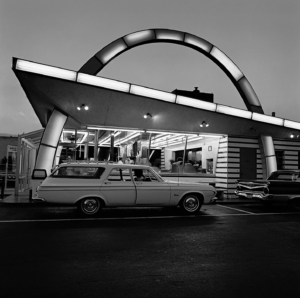
Roger Minnick is the voice and the heart of Southern California, especially in the 1970s and 80s. This was the California that the rest of the USA flocked to. Surfin’ USA!
Minnick always has had his finger on the pulse of the state. He just “gets it.”
For more work by the incredible Minnick, see: https://www.rogerminick.com/southland
West Texas seems vast, seamless, endless and infinite.
But consider the Universe!
No walls. No boundaries?
No end we can even imagine.
Can you get your head around that?
I cannot.
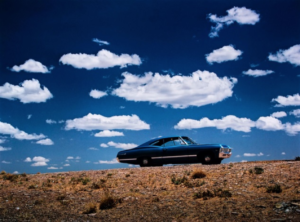
I studied with Ernst, briefly, in 1979. He was a great guy, very honest and one of the most elegant people I ever met. He got excited by Mahler while everyone else was getting excited by the Rolling Stones!
His photography mirrors that elegance. Whether it was for himself or a commercial client (he did a lot of really great stuff for Lufthansa) the work was always personal and usually intriguing.
Enjoy Ernst: http://bit.ly/2BlQZcB
Migrant Father, June 1938, by Dorothea Lange
Dorothea Lange’s extended caption:
Old time professional migratory laborer camping on the outskirts of Perryton; Texas at opening of wheat harvest. With his wife and growing family; he has been on the road since marriage; thirteen years ago. Migrations include ranch land in Texas; cotton and wheat in Texas; cotton and timber in New Mexico; peas and potatoes in Idaho; wheat in Colorado; hops and apples in Yakima Valley; Washington; cotton in Arizona. He wants to buy a little place in Idaho
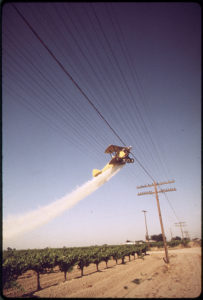
The DOCUMERICA project was created in 1972 and its Director, Gifford Hampshire, tried to recreate the all-encompassing visual story of America that Roy Stryker began in 1936 with the Farm Security Administration project that told the story of the Depression and, more generally, the story of America as it struggled through the Depression and then toward the end in 1939, told the story of a strong America, preparing for war.
Charles O’Rear was one of the notable photographers for DOCUMERICA. For more about him, including the story of how he created Bliss (the iconic Microsoft screen image) view: https://youtu.be/_G5Z8aMctBw
Photo by Leonard Nadel
Editor’s Note: The Bracero program addressed the issue of demand for labor and the need for work. It was a cooperative program that allowed America’s work needs to utilize the need of Mexico’s workers’ need for employment. It was legal, it was effective and it was a clear win-win program. Therefore it did not last. Too logical. And here we are now, 52 years later, with America needing workers, Mexicans needing employment and total chaos at the border. One could ask, is this chaos or planned exploitation?
Here is a mini-history of the Bracero Program. Let the discussion begin.
Text by Smithsonian National Museum of American History The Bracero program (1942 through 1964) allowed Mexican nationals to take temporary agricultural work in the United States. Over the program’s 22-year life, more than 4.5 million Mexican nationals were legally contracted for work in the United States (some individuals returned several times on different contracts). Mexican peasants, desperate for cash work, were willing to take jobs at wages scorned by most Americans. The Braceros’ presence had a significant effect on the business of farming and the culture of the United States. The Bracero program fed the circular migration patterns of Mexicans into the U.S.
Several groups concerned over the exploitation of Bracero workers tried to repeal the program. The Fund for the Republic supported Ernesto Galarza’s documentation of the social costs of the Bracero program. Unhappy with the lackluster public response to his report, Strangers in Our Fields, the fund hired magazine photographer Leonard Nadel to produce a glossy picture-story exposé.
Presented here is a selection of Nadel’s photographs of Bracero workers taken in 1956: shttp://s.si.edu/1gRD3VJ for Nadel’s photographs and other resources.
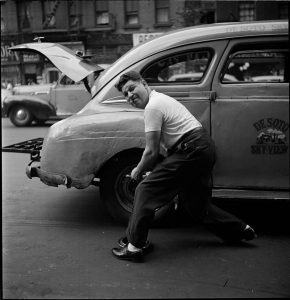 Changing the Tire, Photograph by
Changing the Tire, Photograph by
Stanley Kubrick, 1946, for Look Magazine
Not many people think of Stanley Kubrick as a still photographer. After all, the creator of such monumental classics as 2001: A Space Odyssey, Dr. Strangelove and Lolita is etched in our brain as the grand American cinematic auteur.
But, even before all that, he was roaming the streets of New York City, grabbing life as he knew it. He did assignments for major publications of that era, and apprenticed with and later became a staff photographer for LOOK magazine, one of the two giant picture magazine (the other being LIFE).

At LOOK he photographed such greats as Frank Sinatra and Erroll Garner to George Lewis, , Papa Celestin, Alphonse Picou, Muggsy Spanier, Sharkey Bonano, and many of the greatest jazz musicians of the New York scene. It wasn’t until 1948 that Kubrick took an interest in cinema after viewing films at the Museum of Modern Art’s film screenings.
For more on Kubrick: https://twistedsifter.com/2011/12/stanley-kubricks-new-york-photos-1940s/
and: https://en.wikipedia.org/wiki/Stanley_Kubrick
Tenant farmer moving his household goods to a new farm.
Hamilton County, Tennessee, Rothstein, Arthur, 1937 (LOC)
Ten Children, March 1937, by Dorothea Lange,
for the RA (courtesy of OMCA)
The Funklands are where you find them, and, when.
Bruce Berman started this project when he was in his early 20s, in the 1970s, and just starting out in photography. He cruised the highways and the low-ways of America, no particular agenda, stopping often (to the consternation of those driving with him), always looking for the funk, the detritus of other eras, the iconography of his youth and the times before him.
This America is now almost gone. It hangs over bars in places like Austin or Madison, Los Angeles or Chicago. The Funklands have turned into “Fly Over” territory, still there, still quasi rural, but now, unrobed. The structure of the Funklands, textured, bold, spectacular, has been replaced by franchised plastic, flatness, sameness.
We celebrate corporate identity in the iconography of now, not roosters and skeletons and old Cadillacs.
The Funk has turned from delight to nothingness. Occasionally there is a McDonald’s that riffs on a local theme, but pretty much not.
The Funk is hard to find.

Text by Bruce Berman
All Commentary (definitely) Subjective
The Farm Security Administration (FSA) started out to show government programs to the taxpaying public, to gain support for the New Deal agriculture initiatives of the Resettlement Administration (RA). From mid 1936 to late 1939 it did that but in the doing it found itself -pushed by the hand of its Director, Roy Stryker- documenting “American Life.”
The beginning of the FSA concentrated on the devastation of people and land of the agrarian sector but, as time went on, it broadened its image-making to include the way all Americans lived and worked.
The America of the 1930s is still out there, in the backlands, far away from the eyes of urban America. In fact, if one only learned of the interior of America from the mainstream media (all situated in urban America) one could not know that the America of the 1930s FSA is ongoing, alive, and functioning.
These images are a sample from the FSA road, a road I travel often, now, in 2015, seventy nine years after the creation of the FSA and their portrayal of America.
Then as now it is typified by open space, graphic simplicity and, agriculture and a sense of order now uncommon in urban America.
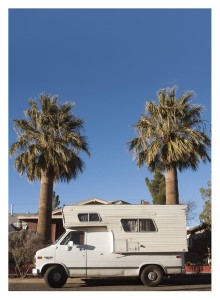
Text and Photograph by Bruce Berman
Funk.
There’s a little left.
The era of funk is passing.
What’s left is either pure decay or rot from an era of plastic, synthetics and lack of design distinction.
What would you rather see, a decaying car from the 40s, 50’s or 60s or a decaying anything from afterwards? Afterwards it’s just junk that was of little endearment before it fell into disuse.
Besides, the stuff from the post war era is almost gone, all hung up in bars in places like Austin, Portland, Cincinnati, Boca Raton and Chicago.
Authentic ruin is hard to come by. It’s a good investment for those who aspire to never ever actually live with it.
The “backlands” of the USA are either redeveloped or falling into unlivable ruin.
There are people in there, by choice or circumstance.
My next era of work will be an exploration of Authentic Ruin in the Backlands.
Kimball the American, El Paso, Texas, by Bruce Berman
Commentary by Bruce Berman, Editor
Why is it the street guys not only aren’t shy about flying “Old Glory,” but are vigorous in telling you why they love it? Compare this to any college campus. Not only can you not find a glimpse of the Stars and Stripes, there are numerous organizations that want it -or anything it represents….like the military- anywhere near it.
Is a puzzlement or is it an insight?
Perhaps, as we look at the condition of the country and the rumors of its demise, we need to start looking to the streets for some answers, not to the walls of academe.
Viva Kimball.
Hungary Baths by Amy Vitale©2011
From Ami Vitale’s website (http://www.amivitale.com):
Ami Vitale’s journey as a photojournalist has taken her to more than 75 countries. She has witnessed civil unrest, poverty, destruction of life, and unspeakable violence. But she has also experienced surreal beauty and the enduring power of the human spirit, and she is committed to highlighting the surprising and subtle similarities between cultures. Her photographs have been
exhibited around the world in museums and galleries and published in international magazines including National Geographic, Adventure, Geo, Newsweek, Time, Smithsonian. Her work has garnered multiple awards from prestigious organizations including World Press Photos, the Lowell Thomas Award for Travel Journalism, Lucie awards, the Daniel Pearl Award for Outstanding Reporting, and the Magazine Photographer of the Year award, among many others.
Now based in Montana, Vitale is a contract photographer with National Geographic magazine and frequently gives workshops throughout the Americas, Europe and Asia. She is also making a documentary film on migration in Bangladesh and writing a book about the stories behind the images.
Andrea Bruce is a passionate, stylish, skilled documentary photography who’s images -in the best traditions of still photography- sear your soul and drive their point through your heart, restoring it instead of terminating it. She is the new breed of documentary photographer that blends all the skills of good journalism with all the skills of great graphic image-making and produces a coctail that is nothing less than photo alchemy.
Take a look: http://www.andreabruce.com
Sometimes we forget that the “Big Work,” the work that one becomes known for making isn’t all there is.
Bruce Davidson went south, from Chicago, on instinct.
The world was shaking and he felt the vibe.
The time was now: Civil Rights.
Real change.
Without assignment or specific destination he “nailed it,” and was able to work on the edges of the news, tell the story from a personal and deeply intimate viewpoint.
This image, for me, is one his best. Beautiful composition. Beatiful moment. Beautiful storyline. Iconic and packed with all the elements that make it a novel unto itself, if this was the only photography that existed from the era it was shot in, it would, I think, be enough to tell the story of the struggle.
One word and one image: sometimes it’s enough: Vote.
For More on Bruce Davidson: http://en.wikipedia.org/wiki/Bruce_Davidson_(photographer)
©Victor Sera
GO TO: http://www.fiftycrows.org/index.php#mi=2&pt=1&pi=10000&s=1&a=7&p=0&at=3
This is a photo essay on the lives of the undocumented as they navigate between their homes and their country chosen for work.
In some ways the “landscape,” of this document has changed since it was photographed in the 1990’s. The immigration interdiction efforts by the United States has reduced the number of migrants and, more recently, the lack of jobs in the U.S. due to the faltering economy has reduced it even further. The personal plight for migrants in the U.S. has changed for the worse, making any return to the mother country impossible due to the danger of the return journey.
This document, however, is still quite valid. The existential delemna of home and heart weighed against stomach and uprootedness is ongoing, worldwide and, as this work shows, problematic.
SEE: http://mediastorm.org/0023.htm
A documentary project on Displacement…in the “Heartland!
This photographer shows how “progress,” comes to everywhere and the displacement is not limited to indigenous people either. In the end it is the interests of Capital weighed against the interests of Labor that is the issue of land appropriation and displacement.
Let this documentary speak for itself.
This is one way to approach Documentary. Severely remove all elements of the subject except the subject itself.
Notice that without a background the photographer absolutely controls the statement.